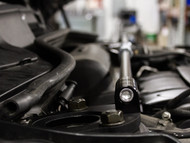Braced for impact.
Posted by Jacob on 21st Dec 2018

We’ve been dealing with chassis issues since the R53. The sheet metal that the front struts bolt to has been notoriously weak. The R56, while more sturdily constructed than the previous generation, still has quite a bit of flex up front. This makes the car less stable and less predictable around corners which is equal parts less safe and less fun.
Traditional strut bars for many vehicles are typically large, awkward assemblies that, even when constructed accurately, assume certain location tolerances on the vehicle from factory. This means that not only are they a pain to have fabricated and shipped, there’s no guarantee of proper fitment while installing.
Our approach was to design a multi-piece construction that can be assembled and disassembled quickly and easily, is completely reversible, low profile, and 100% accurate every time. Regardless of any manufacturing irregularities, or how many miles are on your vehicle, whether you track it regularly, use it as a daily driver, or only take it out on the weekends, this strut bar will self-correct as you install it.
The base plate is the most important part of the assembly, as any poor design choices in this stage will be magnified once everything is put together. Precision machined from billet 6061 aluminum to a final thickness of ½”, the left and right sides are mirrored versions of each other. With cutouts to avoid any interference, the bases mount flat and secure to the top of the struts using our custom strut bolt adapters.

A lot of designs on the market use the existing strut stud nuts to secure the end plates. This requires that the end plates be very thin, so that you can leave enough room to thread the nut on. Since we wanted our brace to serve as strut tower protection as well, we designed an adapter for the strut studs which extends them and allows us to use a full half inch thick end plate. Very similar to Strut Tower Defenders we make for the R53.
Of course, what matters is how the base plates are connected to each other. An obvious choice is a piece of bent tubing that is flattened on both ends with a few bolt slots cut into it. This has a few critical disadvantages. All of the forces that cause the chassis to flex would be focused on the bolt heads that fasten the bar to the base plates. Installed incorrectly, the bolts could either snap or cause the bar to slide around, defeating its purpose. It is also much more costly to protect and ship.
Two solid bars joined with a turnbuckle are not only compact and rigid, but are adjustable in order to place the forces properly onto the base plates. Once mounted properly to the bar blocks, the bars are then joined with the turnbuckle, and nuts on either side keep the turnbuckle firmly in place.

This puts all of the pressure on the bar blocks. These special adapters look simple, but are exceptionally important to get right. They are precisely mounted to the base plates with massive countersunk bolts, transitioning any forces place upon them onto the base plate. The hole which accepts the bar is bored out at an angle to compensate for the slight angle at which the front struts are mounted.

All of the included components are either anodized aluminum or galvanized steel. With little risk of corrosion, this assembly mounts perfectly to every vehicle and will stay looking sharp for years to come.
